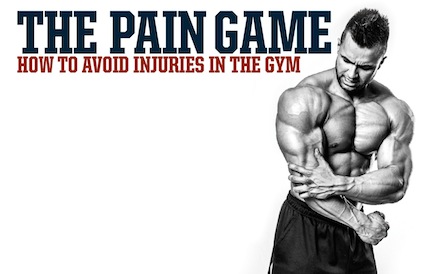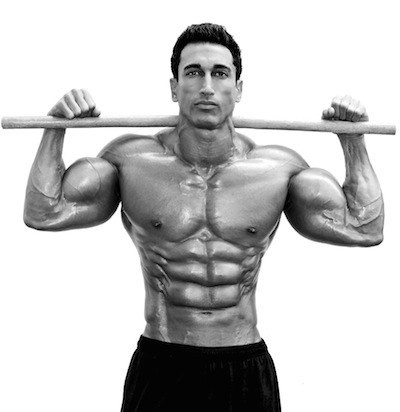10 Most Common Causes of Injury

Avoiding a PAIN IN THE MASS
You don’t get something for nothing when you’re doing weight training. Forcing your body to develop, grow, and get stronger involves regularly subjecting your muscles, tendons, joints, and ligaments to the maximum stress that they can handle. It’s no walk in the park. Serious bodybuilders know from experience that you probably haven’t trained hard enough unless you’re sore for two days after a hard workout.
The problem is that it’s difficult not to go over the limit when you’re trying to work to the limit. When that happens, you’re subject to injury, and injuries can slow down your progress—and take away your motivation—more decidedly than almost anything else. So part of knowing how to do weight training effectively is learning how to avoid injuries before they happen. There’s no way to guarantee you can make yourself totally injury-proof , but following are 10 of the most common causes of injury, and how to avoid them.
#1 INCORRECT TECHNIQUE
The most common cause of injury in the gym is incorrect training technique. Using incorrect technique can cause you to rip, tear, pull, or strain vulnerable muscles, joints, or connective tissue. Losing control of a barbell or dumbbell can cause instant injury that may require a long time to rehabilitate.
Many people aren’t sufficiently aware of the specific technique required in each different exercise—both to obtain effective results and to protect the body from being subjected to stresses and strains that could lead to injury. So it’s never too early to become an expert on how to do each movement with each piece of equipment as technically correct as possible—working at the proper angle and through the correct range of motion and keeping the weight you’re using totally under control, with no jerking or bouncing, no excess “cheating” (see below), and therefore no excessive strain on the tissue and structures involved in the movement.
“Technique should be your first priority,” says Lisa Reed, MS, CSCS, director of Strength and conditioning at the National Cathedral School in Washington, D.C. “Getting stronger and working with heavier resistance comes later.”
#2 TOO MUCH WEIGHT
Effective weight training is a system that involves a combination of resistance plus endurance. Ideally, you should be using about 75 percent of your one-rep maximum in each exercise, which allows for a certain number of reps in each set (usually 8 to 12 for upper body movements and 12 to 16 reps for legs, with some individual variation).
“Lifting heavier than you should does not increase your development,” explains Jimmy Pena, MS, CSCS, Athletic Director of the Ritz Carlton Resort in Half Moon Bay, California. “You have to keep in mind that what you’re doing is weight training, not weight lifting. Lifting too heavy definitely increases your vulnerability to injury, since heavier weights put a greater than necessary stress on the various structures of the body and makes the weights that much harder to control.”

Effective progressive resistance weight training does involve gradually adding weight to your exercises, but not if increasing the resistance decreases your reps to below the minimum requirements. If you can’t do enough reps, you’re training too heavy. If you find you can’t do your sets using strict technique, that’s also a sign you’re using too much weight in that exercise.
#3 TRAINING TOO LONG OR TOO OFTEN
Success in weight training, the experience of modern bodybuilders has proven, comes from short sessions of intense workouts and then enough time between workouts to allow for sufficient rest and recuperation. You stimulate growth when you train, but you grow when you rest.
There’s a saying that you can train hard or train long, but not both. If your workouts take too long, you’re probably pacing yourself and not training with full intensity. Plus, frequent long training sessions prevent you from experiencing full recuperation, and when you train tired on a regular basis, you increase your changes of both acute injury—a sudden, traumatic incident—or chronic problems that come with long-term wear and tear. So to avoid depleting and weakening your body and to help create maximum positive response from your gym exercise, consider reducing your workouts to three or four a week and keeping your training sessions under an hour.
“You should be somewhat sore after a hard workout,” Lisa Reed points out, “usually for a day or two. But if you are so sore you can’t function normally or the soreness persists too long, it is likely you have pushed your body too hard and you should cut back somewhat on the frequency or volume of your training sets.”
#4 INCORRECT USE OF CHEATING AND FORCED REPS
Cheating is a method of forcing your muscles to handle weights beyond the amount you could use doing strict reps. You cheat by using other muscles than the ones targeted in the exercise to “swing” the weight and use the power of momentum to add to your lifting power. Forced reps involve having a training partner help slightly with a lift so that you can handle weights you wouldn’t be able to lift on your own.
Both these techniques have value in an advanced workout. But they also put added stress on your body and increase the chance of injury. When you do too much cheating, the inertial forces involved can be dangerous if you lose control of the weight. Plus, you tend to “jerk” the weights around, which can sometimes cause damage. “Doing forced reps involves using weights that are by definition too heavy for you to handle on your own,” points out Lisa Reed, “so you have to depend on the good judgment of your training partner not to make a mistake that subjects your body to too much stress.”

#5 BAD SPOTTING
If you lift heavy enough, especially in certain exercises (bench press and squats, for example), you will eventually need a spotter to help. When you’re working as hard as you should, you will occasionally get “stuck” doing a rep. That’s why you need a spotter to help you control the weight and to finish the rep safely. But a good spotter needs to pay very careful attention to what the person being spotted is doing and to train him or her as if he or she were always on the verge of total failure. A spotter should be attentive to whether you need a little or a lot of help in completing your reps, ever alert to the possibility of failure—not looking around or talking with friends.
#6 INADEQUATE WARM-UP
When you warm up a muscle by doing fairly high reps with light resistance, you pump a lot of blood through the area and literally “warm up” the temperature of the involved areas of the body while decreasing blood viscosity and promoting flexibility and mobility. A muscle that has been warmed up properly is much better able to deal with the kind of sudden stress it is subjected to in weight training.
An overall, general warm-up before working out can be beneficial, including light aerobic exercise. But it’s also necessary to warm up for a specific exercise by doing light reps of that specific exercise, thereby targeting the muscles, joints, and connective tissue directly involved. Actually, the longer you’ve been training and the stronger you are, the more important warming up becomes. A strong individual is more capable of generating the kind of muscular force that can cause injury than somebody who isn’t as strong. One approach to training that is common is “pyramiding”—beginning each exercise with lighter weights and higher reps and then gradually adding weight and reducing reps with each succeeding set, giving the body time to warm up using the specific areas involved in that particular movement.
#7 NOT STRETCHING SUFFICIENTLY
Flexibility is one of the basic foundations of fitness, along with strength and cardiovascular conditioning. Any program of stretching that promotes flexibility is good for your overall level of fitness and health. But when it comes to weight training, you need to stretch in a way that is of specific benefit for particular exercises. “The best way to stretch for weight-training movements is by doing light, full-range-of-motion repetitions with the specific exercises themselves,” Jimmy Pena says. “You don’t get the same benefit from generalized stretching stretching exercises or programs.”
It’s all too common to find injuries to muscles, joints, and connective tissue happening at a full-range-of-motion position, when all the tissue is being stretched to the greatest degree. This can easily happen when you’re working with heavy weights because the momentum this creates can contribute to your extending past your normal and comfortable extreme range in a given movement. Careful attention to technique can reduce this risk, but so can stretching the areas involved as part of your warm-up; you not only pump the muscle and warm it up with light sets but also work through the longest range of motion possible and increase the flexibility of the areas involved.

#8 DOING NEGATIVE REPS
Negative (eccentric, or lowering) reps are one of the most difficult and dangerous of all weight-training techniques, although they’re very effective for promoting additional stimulation for muscle growth for advanced bodybuilders. Negatives are particularly risky because they involve handling amounts of weight that are really too heavy for you to lift—and may be the heaviest poundages you ever train with.
You can lower a weight that is considerably heavier—about 130 percent more—than the amount you can lift. But using this technique requires the help of strong, experienced spotters since you could be seriously injured if the weight were to get away from you. Additionally, lowering a weight causes more microtrauma to muscle tissue—including increased soreness—so performing heavy negative reps too often can lead to subsequent damage to the tissues involved. So negatives need to be done very carefully and not too often.
“I wouldn’t even recommend doing negatives for a specific body part as often as once a week,” Jimmy Pena says. “The wear and tear on the body is too great and the time required for complete recovery is too long.”
#9 POOR NUTRITION
The more stress you put on your body during training, the better your nutrition needs to be to support your efforts. Nutritional deficiencies that aren’t apparent during your normal life can begin to show up when you undertake a program of intense weight training. This is particularly true during periods of caloric restriction for weight loss. When you’re eating less in order to lose body fat, it’s all too easy to experience various degrees of nutritional deficiency that can weaken your body and reduce your ability to recover from hard workouts.
“One common problem,” says Lisa Reed, “is eating too few carbohydrate calories while you are dieting to provide the energy necessary for intense training. Not only does this lower the intensity of your workouts and slow down recovery, but diets too deficient in carbs cause the body to begin metabolizing lean body tissue for energy at an increase rate.” One strategy to avoid this is to avoid strict dieting during the periods in which you’re doing your heaviest training.
#10 LACK OF CONCENTRATION
Intense weight training is a difficult and sometimes risky type of exercise, although it’s also one of the most rewarding in terms of achieving maximum results. Working with free weights and machines in a gym and avoiding a wide range of potential injuries requires you to learn to keep your mind on what you’re doing at all times and to think about what you’re doing. You will get the most benefit and maximize your chances of avoiding even minor injury by learning to concentrate your attention on the task at hand. The gym is not the place to let your mind wander and not pay attention. To train safe, you need to also train smart.

